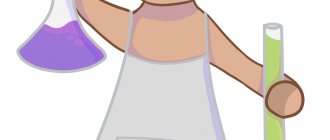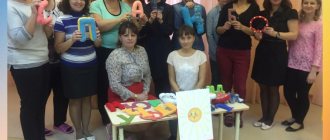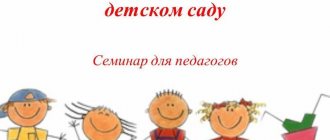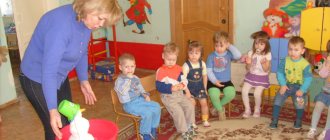Let's decide together
Can't enroll your child in kindergarten? Would you like to tell us about the teachers? Do you know how to improve your diet and exercise?
Municipal budgetary preschool educational institution, kindergarten of general developmental type No. 11 “Firefly” of the Municipal Entity Timashevsky District (MBDOU d/s No. 11) was opened in 1966.
If there is an island of love, joy, and happiness on Earth, then this is MBDOU d/s No. 11 “Firefly”. Our preschool educational institution is a living organism that breathes, feels, and rejoices. We try to penetrate every child's heart, instill in it joy, love, kindness. Preschool educational institutions are parents. They are the main assistants in our work and we are very grateful to them for this. Preschool educational institutions are employees. The most hardworking, creative people who can do everything, who care about everything with their souls, who love children. A preschool is a big family. And like any friendly family, we have our own traditions. If you want your baby to feel comfortable, to develop in accordance with his capabilities and abilities, come to us at the Firefly kindergarten.
The preschool educational institution operates in accordance with the Federal Law “On Education in the Russian Federation”. A license was issued for the right to carry out educational activities under educational programs dated March 12, 2013 No. 05353. The preschool educational institution has a license to carry out medical activities dated December 5, 2012 No. LO-23-01-005240.
The preschool educational institution ensures a high level of development of preschool children in accordance with their age and individual characteristics. Contributes to the preservation of physical and mental health, intellectual, artistic and aesthetic, social and moral development, emotional comfort of the child and his socialization.
The preschool educational institution works according to the “Basic general educational program of preschool education.”
In addition to the basic forms, teachers use new methods, technologies, and partial programs in their work:
- “Education of ecological culture among preschool children” (S.N. Nikolaeva)
“Fundamentals of the safety of preschool children” (R.B. Sterkina,)
MAIN TASKS OF EDUCATION AND TRAINING IN KINDERGARTEN:
- protecting the lives and strengthening the physical and mental health of children;
- ensuring the intellectual, personal and physical development of the child;
- introducing children to universal human values;
- interaction with the family to ensure the full development of the child.
PRIORITY DIRECTIONS:
- protecting the lives and strengthening the physical and mental health of children
- artistic and aesthetic education of children;
- interaction with the family to ensure the full development of the child.
The teachers will make sure that your child becomes independent, sociable, active, inquisitive, learns to think, develops his creative abilities, joins the world of art, and learns to create his own artistic creations; musical director L.E. Chernyavskaya will reveal the talents of your baby and he will become a real little artist; work on moral and patriotic education is carried out, skills and abilities in visual arts are improved, taking into account the age characteristics of children. Work is underway on environmental education in all groups, there is an environmental classroom “Ladybug” in which senior students conduct experiments and experiments, based on the developments of the programs “Young Ecologist” by S.N. Nikolaeva and “Our Home is Nature” by N.A. Ryzhova. Children develop a conscious attitude towards natural phenomena, towards themselves and their health. At the preschool educational institution a complex of health-improving and educational activities is carried out, the basis of which is motor activity, these are: physical education classes; physical education and health work during the day (morning exercises, physical education minutes, outdoor games and physical exercises, hardening activities, gymnastics after sleep, “health paths”); active recreation (physical education and holidays, health days, vacations); health services: phytoncidotherapy.
We provide additional development of children’s individual abilities in the “Bell” - vocal circle.
Pedagogical principles of the team:
We raise friendly, cheerful and resourceful people. We warm you with affection, warmth, care. We develop healthy, strong, dexterous people. We sow reasonable, good, eternal things.
Every child in our garden is a clear star. And this star shines brighter because she knows that she is loved and valued, knows that she will not be abandoned, but will be helped to achieve perfection.
Dear mothers and fathers, grandparents!
We are glad to welcome you to our website!
Why did we open our website on the Internet?
In order to tell more about the preschool institution, which has become a second home for us, about the kind and creative employees who give a piece of their soul and warmth to our dear students, as well as about the children themselves, whose upbringing and education we consider the most important activity. We strive to ensure that the preschool educational institution is for everyone who visits it a home in which comfort, coziness and kindness reign, where music and sonorous children's laughter are heard, a home to which they come with joy.
On this website you can get all the necessary information about the life of our kindergarten.
You can find out information about how we live. We will talk about past events and significant dates. You can look at our photo album and learn from us some experience in conducting classes and consultations.
- In the “Guest Book” section you can contact us and leave wishes and comments on the work of the preschool educational institution in general, as well as get acquainted with the opinions of other parents;
- The “Kindergarten Events” and “News” sections contain notes of classes and events conducted by our teachers;
- The “Garden Tour” section contains photographic materials of the territory of the preschool educational institution, interesting events held in the preschool educational institution, etc.;
- In the “Information for Parents” section you will find a lot of interesting things: games, poems, songs, riddles and much more;
- In the “Recommendations from Experts” section you can find consultations for educators and parents.
We hope that our site will be useful to both parents of pupils of our preschool educational institution and many others. If you have questions regarding MBDOU d/s 11, you can ask them to our email address.
We are waiting for you at:
Krasnodar region, Timashevsk microdistrict. Sugar factory 8.
tel./fax: 8 (86130) 5-35-77
Sincerely, Head of MBDOU d/s No. 11 Avramenko Tatyana Andreevna
Workshop. “Project activities in preschool educational institutions”
Transcript
1 State budgetary preschool educational institution kindergarten 14 of a general developmental type with priority implementation of activities for the artistic and aesthetic development of children in the Krasnogvardeisky district of St. Petersburg Workshop “Project activities in preschool educational institutions”
2 Goal: Clarification and expansion of teachers’ knowledge about project activities in a preschool educational institution. Promote creative exploration. To increase the methodological level of teachers in their mastery of design technologies. Improve the pedagogical skills of educators. Creating a system of work to implement technology - the “project method”. Objectives To provide conditions for the development of creativity and professional activity of teachers in their mastery of design technologies
3 A unique means of ensuring cooperation, co-creation between children and adults, and a way to implement a person-centered approach to education is design technology.
4 The technology of project activity is not fundamentally new in world pedagogy. W.H. Kilpatrick believed that a project was any activity carried out "from the heart", with a high degree of independence, by a group of children united at the moment by a common interest. In Russia, S.T. was the first to put design ideas into practice since 1905. Shatsky. The project method was widely used in Russia until the 30s. years, but by a resolution of the Central Committee of the All-Union Communist Party of Bolsheviks in 1931, the project method was condemned as alien to the Soviet school. J. Dewey ( ) believed that childhood is not limited to preparation for adult life. Childhood itself is a full-fledged period of human existence. This means that education should provide not only knowledge, skills and abilities.
5 What is the significance of using the project method in a preschool educational institution: The project method is based on the interests of children and assumes the independent activity of pupils. Only by acting independently, children learn in different ways to find information about an object or phenomenon that interests them. Using the project method in working with preschoolers helps to increase the child’s self-esteem. The project method promotes the development of favorable interpersonal relationships in a group of children. There is a change in the style of communication between an adult and a child. Parents become active participants in the educational process. Using the project method in a preschool educational institution helps teachers and students learn to work in a single team; they develop their own algorithm of actions to achieve their goals; teachers are free to choose methods and types of activities. Even an unsuccessful project contributes to the development of professionalism. Analysis of project activities and understanding of mistakes create motivation for repeated activities and encourage the teacher to self-educate.
6 Translated from Greek, a project is a path of research, i.e. a set of actions specially organized by an adult and independently carried out by children, culminating in the creation of creative works. The project method is a teaching system in which children acquire knowledge in the process of planning and performing increasingly complex practical tasks - projects. The project method always involves students solving some problem.
7 The goal of the project method is to develop the free creative personality of the child. What is a project for the child himself? Unlocking creative potential; Ability to work in a group; The ability to direct activities to solve an interesting problem formulated by the children themselves; Ability to present your work. The core of the technology of project activities is children’s independent research, cognitive, and productive activities, during which the child learns about the world around him and embodies new knowledge into real products.
8 Types of project activities By composition of participants By content By duration By dominant type of project activity Individual Subgroup Family Pair Group Mono-projects (one educational area) Integrative (two or more educational areas) Short-term (1-4 weeks) Medium duration (up to 1 month) Long-term (half-year, academic year) Information Research Creative Project-oriented Gaming Adventure
9 When organizing a project, it is important to take into account the dominant type of activity of children, since they need constant attention from adults at every stage of implementation. The peculiarity of using the project method in preschool practice is that adults need to “guide” the child, help discover a problem or even provoke its occurrence, arouse interest in it and “draw” children into a joint project. But at the same time, it is important not to overdo it with supervision, to give children the opportunity to study and practice the necessary materials themselves.
10 In the practice of preschool educational institutions, the following types of projects are used (according to L.V. Kiseleva). In the educational process of a preschool educational institution, project activities are in the nature of cooperation, in which children and teachers take part, and parents are involved. Parents become direct participants in the educational process. They enrich their teaching experience by experiencing a sense of ownership and satisfaction from their successes and the successes of their child. It is very important for teachers not to lead, but to help parents, to see their strengths, and to be ready to learn from them. Exploratory and creative children experiment and then present the results in the form of newspapers, dramatization, children's design. This type of project is used when working with older children. Role-playing - elements of creative games are used when children take on the characters of a fairy tale and solve problems in their own way. Used in the second junior group. Information-practice-oriented - children collect information and implement it, focusing on social interests (decoration and design of the group, stained glass, etc.) Used in the middle group. Creative - designing the result of the work in the form of a children's party, children's design, etc. This type of project is suitable for children of the second junior group.
11 Project structure Stage 1 Selecting a project topic. A problem, goal, task is formed, and a game situation is introduced. Stage 2 - Planning. The teacher helps in solving the problem using various methods. Stage 3 - Project implementation. The teacher organizes the children's activities. Stage 4 - Completion of the project. The teacher prepares the activity product for presentation. Performance.
12 Thus, the project can be represented as “Six Ps” Problem Project design Search for information Product Presentation Project portfolio
13 Let's consider ways to develop projects: “Three Questions Model” The teacher listens to the children, accumulates a lot of information about their interests and pressing problems that have affected their souls and thoughts. After discussing their observations of children, adults formulate one version of the project topic. It is very interesting to observe how a picture of their worldview is formed from individual, sometimes very unexpected statements and proposals of children. Often adults rediscover children who seem to be familiar to them. Children and their parents take part in filling out the model. The “Three Questions Model” is hung in the group’s locker room, parents take a direct part in working on the topic from the very beginning: on the one hand, they see that a new interesting topic has appeared; see how children and their own child express themselves in this topic; on the other hand, they can immediately make their suggestions, adjustments, and understand where their help is needed. What do I know? What do I want to know? How to find out? Content is what children already know. Plan, theme of the project. A source of new knowledge, i.e. a project.
14 Image “We are seven” (according to Zair-Bek) We are concerned... (a fact, a contradiction, something that attracts attention is formulated). We understand... (a conscious problem to solve and guiding values are presented). We expect... (a description of the expected goals - results is given). We assume... (ideas, hypotheses are presented). We intend... (context of actions planned in stages). We are ready... (a description of the available resources of various types is given). We are asking for support... (the justification for the necessary external support for the implementation of the project is presented). When starting work using the project method, it is very important not only to determine the topic of the project, taking into account the interest of the children. But also to build a systemic web taking into account the requirements of the Federal State Educational Standard. Not only the areas of activity, but also the integration of areas should be clearly visible.
15 System web for the project From the general discussion of the topic, from the “model of three questions”, the basis of the plan is born - both content and by type of activity, taking into account the requirements of the Federal State Educational Standard. The content and form of its implementation will be further developed during the preparation of the “Gossamer” plan. The name of the plan comes from its figurative resemblance to a web, from the center of the topic rays of content, forms, and specific actions diverge, which are filled in and implemented gradually. When developing a “web”, not only the directions of activity, but also the integration of areas should be clearly visible.
16 Main mistakes when organizing project activities with children Presentation of a system of work on any issue in the form of children’s project activities Project participants most often become the same, active pupils of the group At the stage of implementing project ideas, it is very difficult for educators to restrain themselves from direct instructions, direct management of children's activities. Even with good development of the project, you often hear: “Now we will do this,” “Now do this,” the project product turns out to be unclaimed. A project planned for one or two weeks drags on for a month or two. When organizing project activities, educators forget to reflect it in the calendar plans.
17 Conclusion The didactic meaning of project activities is that it helps to connect learning with life, develops research skills, develops cognitive activity, independence, creativity, the ability to plan, and work in a team. Such qualities contribute to children's successful learning at school. But the most important participants in project activities are our students, on whose development all our efforts are directed. Time will tell what our children will become when they grow up. The main thing for us is to provide each child with maximum conditions for the development of his abilities, independence and creativity.
18 Thank you for your attention



